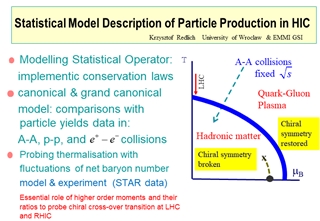JLAB - B, Hadronic matter, Quark-Gluon Plasma, Chiral symmetry broken
-
Upload
-
0
-
Embed
-
Share
-
Upload and view presentations on any device and embed the player to your website! --- > >Upload PPT
- Upload PPT
Download this Presentation
Presentation Transcript
- 1.T B Hadronic matter Quark-Gluon Plasma Chiral symmetry broken Chiral symmetry restored LHC Modelling Statistical Operator: implementic conservation laws canonical & grand canonical model: comparisons with particle yields data in: A-A, p-p, and collisions Probing thermalisation with fluctuations of net baryon number model & experiment (STAR data) Essential role of higher order moments and their ratios to probe chiral cross-over transition at LHC and RHIC A-A collisions fixed x Statistical Model Description of Particle Production in HIC Krzysztof Redlich University of Wroclaw & EMMI GSI
- 2.2 Thermal nature of particle production in HIC All properties of a thermodynamc ensemble in thermal equilibrium are derived from part. function To get a specific value of one fixes from The equilibrium number of particles carrying q
- 3.3 + approximate by experimentally known mass spectrum and include finite width of resonaces Statistical operator and mass spectrum resonance dominance: Rolf Hagedorn Breit-Wigner resonaces Hagedorn mass spectrum
- 4.4 3-parameters needed to fix all particle yields Particle Yields and model parameters Minimal setup of model parameters To account for chemical off-equilibrium effects introduce fugacity parameters in particle momentum distributions: for all particles? J. Rafelski et. al. => introduce on the quark level: Density of hadrons composed of numbers of u,d,s quarks gets a factor: 6-parameters needed to fix all particle yields particle yield thermal density BR thermal density of resonances
- 5.5 MODEL DATA Hagedorn resonance gas and particle multiplicity ratios at RHIC Particle multiplicity ratios P. Braun Munzinger, D. Magestro, J. Stachel & K.R Good description of particle yields, with the statistical operator of HRG formulated in GC- ensemble, in central heavy ion collisions from top AGS up to RHIC . Problems with strangeness yields in non-central collisions at high energy and in central collisions from SIS-AGS. K – yields differ by a factor of almost 20 at SIS! A. Andronic, P. Braun-Munzinger & J. Stachel
- 6.6 Kinetics of abelian charges C.M. Ko, V. Koch, Z. Lin, M. Stephanov, Xin-Nian Wang, K.R Consider: Rate equation Size of fluctuations Equilibrium limit T,V and
- 7.7 conservation on the average exact conservation Consider thermal system with Total Strangenes “S”=0 same suppression factor 1 for S and S= -1 S=1 suppression increases with S and with decreasing collision energy A A A A S S S
- 8.8 i) Strong, quadratic dependence of |S|=1 particles with at SIS ii) strange anti-particle/particle ratios independent of KaoS (GSI-SIS) J. Cleymans, H. Oeschler & K.R.
- 9.9 iii) Scaling properties of particle production yields J. Cleymans, H. Oeschler & K.R. Excellent description of kaon production from SIS to AGS Scaling: similar scaling for : A. Andronic, P. Braun-Munzinger & K.R. subthreshold
- 10.10 A. Tounsi & K.R Strangeness Enhancement from pp to AA increases with: i) strangeness content of the particleii) with decreasing collision energy Decrease of enhancements from SPS to RHIC as predicted in the model Consistent predictions for order of magnitude of enhancements of Omega and Xi at RHIC Centrality dependence not correct when assuming ,however does not need to scale linearly. Assume: NA57 STAR
- 11.11 Canonical statistical model in pp collisions: Using Canonical description of strangeness and Grand Canonical for baryon number and electric change conservations in p-p collisions is a good approximation Using correlation volume instead of strangeness undersatuaration factor could be equivalent: see also I. Kraus H. Oeschler; F. Becattini et al. P. Braun-Munzinger et al. from “QGP” 3
- 12.12 Canonical statistical model in pp collisions: Using Canonical description of strangeness and Grand Canonical for baryon number and electric change conservations in p-p collisions is a good approximation LHC H. Oeschler et al. Observed deviations from Thermal Model predictions !! P. Braun-Munzinger et al. from “QGP” 3
- 13.13 Fixing thermal parameters: Temperature approximately independent of system size and centrality Strong variation of baryon chemical potential with centrality and system size for mid-rapidity data I. Kraus et al. p-p C-C Si-Si Pb-Pb J. Cleymans et al.
- 14.Energy dependence of thermal parameters at chemical freeze-out 14 J. Cleymans et al. A. Andronic et al.
- 15.Particles excitation functions in HG model 15 Braun-Munzinger, Cleymans, Oeschler &K.R. Andronic, Braun-Munzinger &Stachel (09) Nu Xu & K.R. H.Oeschler et al. Problem with canonical description of HADES data: data deviate by factor five from model predictions!! HADES
- 16.The Yields of anti-hypernuclei at RHIC First observation of hypernuclei 1952 by Danysz and Pniewski First observation of anti-hypernuclei by STAR in AU-AU coll. Can we understand yields within the SM? 16 Statistical Model Results Coalesence Model Results N. Sharma et al., A. Andronic et al.
- 17.Charm production in annihilation 17 Jet structure of hadrons production Flavor content of the jets: Can we quantify light and heavy flavor particles within Statistical Model ??
- 18.18 Most hadronic events in high energy e+e collisions are two-jet events Each jet represents an independent fireball 2-jets with 2-jets with sub. decays of “C” and “B” Problem: Open Charm and Bottom shows dramatic deviations from data Subtract the contributions from charm and bottom to lighter particles e.g. C,B contributions to
- 19.19 Canonical effects and charm/bottom mesons Total charge of the system And small Strong Suppression of thermal particle phase-space Strong Enhancement of thermal particle phase-space Charge of the system Charge of the particle
- 20.20 Charm and Bottom particles at LEP, 91 GeV Open charm and bottom well described by thermalisation of thermal fireball with overall Charm= and Bottom= and are entirely coming from Bottom’s decays and agree with model Hidden charm, Y is of non-thermal origin, thus, it does not fit to model systematic!
- 21.Production cross section of relative to 21 Data pA compilation by: A. Andronic, F. Beutler, P. Braun-Munzinger, J. Stachel &K.R. The ratio for the Tevatron energy was derived from the CDF data on and and is for : We have extrapolated the measurements from down to Strong suppression of ratio in relative to different production mechanism in elementary and heavy ion collisions The nuclear modification canceled out in the ratio as the pp value is the same as in the pA Good agreement of Statistical Model and data in PbPb collisions RHIC CDF NA50
- 22.STAR DATA ON MOMENTS of FLUCTUATIONS Mean Variance Skewness Kurtosis Phys. Rev. Lett. 105, 022302 (2010)
- 23. Properties of fluctuations in HRG Calculate generalized susceptibilities: from Hadron Resonance Gas (HRG) partition function: and resulting in: Compare this HRG model predictions with STAR data at RHIC: F. Karsch & K.R. and
- 24.Comparison of the Hadron Resonance Gas Model with STAR data Frithjof Karsch &K.R. K.R. RHIC data follow generic properties expected within HRG model for different ratios of the first four moments of baryon number fluctuations Can we also quantify the energy dependence of each moment separately using thermal parameters along the chemical freezeout curve?
- 25.Mean, variance, skewness and kurtosis obtained by STAR and rescaled HRG STAR Au-Au STAR Au-Au these data, due to restricted phase space: Account effectively for the above in the HRG model by rescaling the volume parameter by factor 1.8/8.5
- 26.QCD phase boundary & Heavy Ion Data QCD phase boundary appears near freezeout line Particle yields and their ratios, well described by the Hadron Resonance Gas Thus: HRG has to be a good description of regular part of QCD partition function in hadronic phase Thus: HRG has to describe LGT thermodynamics
- 27.Kurtosis as an excellent probe of deconfinement HRG factorization of pressure: consequently: in HRG In QGP, Kurtosis=Ratio of cumulants excellent probe of deconfinement S. Ejiri, F. Karsch & K.R. Kurtosis F. Karsch, Ch. Schmidt The measures the quark content of particles carrying baryon number
- 28.Higher moments of baryon number fluctuations 28 If freeze-out in heavy ion collisions occurs from a thermalized system close to the chiral crossover temperature, this will lead to a negative sixth and eighth order moments of net baryon number fluctuations. These properties are universal and should be observed in HIC experiments at LHC and RHIC J. Engels, F. Karsch, B. Friman, V. Skokov & K.R. Figures: results of the PNJL model obtained within the Functional Renormalisation Group method
- 29.Fluctuations of 6th and 8th order moments exhibit strong variations from HRG results: Their negative values near chiral transition to be seen in heavy ion collisions at LHC and RHIC 29 The range of negative fluctuations near chiral cross-over: PNJL model results with quantum fluctuations being included : These properties are due to O(4) scaling , thus should be also there in QCD.
- 30.30 Conclusions The Hagedorn partiction function of the Hadron Resonance Gas is a very good approximation of the regular part of the QCD partiction function: => it reproduces bulk of particle yields meassured form SIS up to LHC energy => it reproduces net proton fluctuations up to 4th order measured at RHIC => It reproduces fully ratios of different susceptibilities obtained on the lattice => it reproduces thermodynamics up to very near T_c obtained on the lattice for different quark masses The 6th and 8th order moments of baryon number fluctuations are excellent probes of chiral cross-over transition in HIC at the LHC and RHIC
- 31.31 Centrality dependence of baryon chemical potential For NA57 the temperature is fixed to from central Pb-Pb collisions: ( the value consistent with recent analysis of A. Andronic et al.)
- 32.32 Strangeness enhancement from p-Be to central Pb-Pb collisions at Canonical model with exact strangeness conservation at fixed and being centrality dependent provides good description of NA57 data if the correlation volume scales as:
- 33.33 Multistrange particle enhancement at RHIC Calculations done at fixed , (Nu Xu et al.) for all centrality Overall agreement is not satisfactory, particularly for Lambda yields
Related










